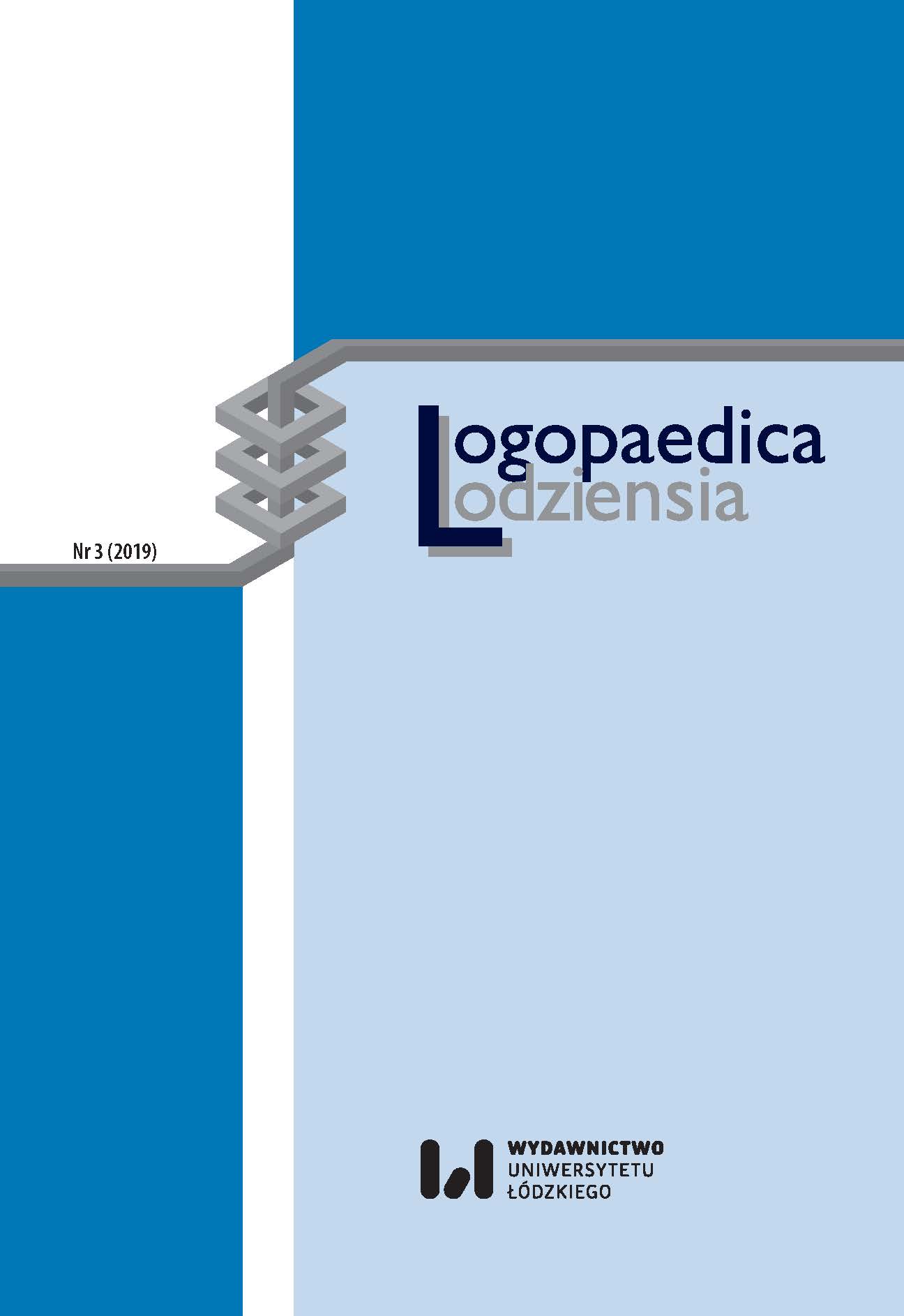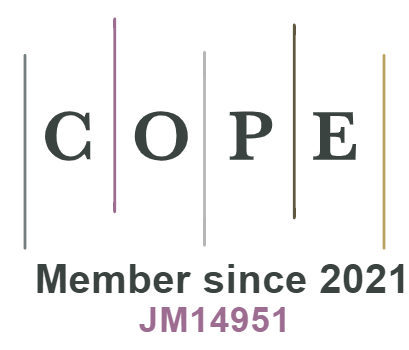Bullying among students with communication disorders – perception of the phenomenon and recommended actions
DOI:
https://doi.org/10.18778/2544-7238.03.05Keywords:
bullying, stuttering/stammering, speech‑language therapist/pathologist (SLT/SLP), teacher, communication disorders, preventionAbstract
The article presents the findings from two research projects on bullying among students with communication disorders. The aim of the first project is to survey the opinions of teachers (n = 53) and speech‑language therapists/pathologists (n = 59) on the prevalence of this phenomenon, its causes and potential remedies. Respondents were also asked whether children with speech‑language problems were more likely to become victims of bullying at school in their opinion. The study also accounts for the respondents’ opinions of potential forms of preventing bullying and preparing students for dealing with this problem in the school setting. In addition, the article presents the results of a pilot study carried out in the framework of workshop meetings organized at the University of Silesia in Katowice. During these workshops, educational activities were carried out with regard to the practical aspects of how to deal with bullying at school. The workshops involved both stuttering children and their parents/caregivers. The authors also discuss the results of a survey conducted among the workshop participants in the form of pre‑ and post‑workshop questionnaires. The paper also includes evaluation of issues such as, bullying at school and potential strategies of dealing with it. The final part of the article, provides examples of strategies of how to support students in dealing with bullying in schools.
Downloads
References
Blood G., Boyle M., Blood I., Nalesnik G., 2010, Bullying in children who stutter. Speech language pathologists’ perceptions and intervention strategies, „Journal of Fluency Disorders”, vol. 35(2), s. 92-109.
Google Scholar
DOI: https://doi.org/10.1016/j.jfludis.2010.03.003
Boroń A., Michta A., Sakwerda A., Węsierska K., 2019, Zajęcia z pomysłem. Scenariusz warsztatów dla nauczycieli. Scenariusz warsztatów dla uczniów, „Forum Logopedy”, nr 31, s. 30–34.
Google Scholar
Card N. A., Hodges E. V., 2008, Peer victimization among school children: correlations, causes, consequences, and considerations in assessment and intervention, „School Psychology Quarterly”, vol. 23(4), s. 451–461.
Google Scholar
DOI: https://doi.org/10.1037/a0012769
Dambach K. E., 2003, Mobbing w szkole: jak zapobiegać przemocy grupowej, Gdańsk: Gdańskie Wydawnictwo Psychologiczne.
Google Scholar
Davis S., Howell P., Cooke F., 2002, Sociodynamic relationships between children who stutter and their non‑stuttering classmates, „Journal of Child Psychology and Psychiatry”, no. 43, s. 939–947.
Google Scholar
DOI: https://doi.org/10.1111/1469-7610.00093
Erickson S., Block S., 2013, The social and communication impact of stuttering on adolescents and their families, „Journal of Fluency Disorders”, vol. 38(4), s. 311–324.
Google Scholar
DOI: https://doi.org/10.1016/j.jfludis.2013.09.003
Gebauer K., 2007, Mobbing w szkole, Warszawa: Instytut Wydawniczy PAX.
Google Scholar
Greene R., 2014, Trudne emocje u dzieci. Jak wspólnie rozwiązywać problemy w domu i w szkole, Warszawa: Wydawnictwo Edgard.
Google Scholar
Hershkowitz I., Lamb M. E., Horowitz D., 2007, Victimization of Children with Disabilities, „American Journal of Orthopsychiatry”, vol. 77(4), s. 629–635.
Google Scholar
DOI: https://doi.org/10.1037/0002-9432.77.4.629
Kuros K., Węsierska K., 2013, Rola nauczyciela w promowaniu dobrej komunikacji w środowisku szkolnym, [w:] E. Kochanowska, J. Skibska (red.), Nauczyciel wobec wyzwań współczesności.
Google Scholar
Dylematy, poszukiwania i inspiracje, Bielsko‑Biała: Wydawnictwo Naukowe Akademii Techniczno‑Humanistycznej, s. 267–277.
Google Scholar
Langevin M., 2000, Teasing and Bullying. Unacceptable Behaviour. The TAB Program, Edmonton: Istar.
Google Scholar
Langevin M., 2013, Dokuczanie i znęcanie się nad jąkającymi się dziećmi, kwestionariusz dla dzieci, wersja zaktualizowana (Teasing and Bullying Questionnaire for Children Who Stutter – Revised), tłum. K. Węsierska, M. Węsierska, http://centrumlogopedyczne.com.pl/narzedzia/ (dostęp: 16.06.2019).
Google Scholar
Langevin M., 2015, Bullying Experienced by Youth Who Stutter. The Problem and Potential Intervention Strategies, [w:] K. O. St. Louis (red.), Stuttering Meets Stereotype, Stigma, and Discrimination. An Overview of Attitude Research, Morgantown: West Virginia University Press, s. 71–90.
Google Scholar
Langevin M., Bortnick K., Hammer T., Wiebe E., 1998, Teasing/bullying experienced by children who stutter. Toward development of a questionnaire, „Contemporary Issues in Communication Science and Disorders”, vol. 25, s. 12–24.
Google Scholar
DOI: https://doi.org/10.1044/cicsd_25_S_8
Langevin M., Packman A., Onslow M., 2010, Parent perceptions of the impact of stuttering on their preschoolers and themselves, „Journal of Communication Disorders”, no. 43, s. 407–423.
Google Scholar
DOI: https://doi.org/10.1016/j.jcomdis.2010.05.003
Lindsay G., Dockrell J. E., Mackie C., 2008, Vulnerability to bullying in children with a history of specific speech and language difficulties, „European Journal of Special Needs Education”, no. 23, s. 1–16.
Google Scholar
DOI: https://doi.org/10.1080/08856250701791203
Little L., 2001, Peer victimization of children with Asperger spectrum disorders, „Journal of the Academy of Child and Adolescent Psychiatry”, no. 40, s. 995–996.
Google Scholar
DOI: https://doi.org/10.1097/00004583-200109000-00007
Little L., 2004, Victimization of children with disabilities, [w:] K. A. Kendall‑Tackett (red.), Health consequences of abuse in family. A clinical guide for evidence‑based practice, Washington: American Psychological Association, s. 95-108.
Google Scholar
DOI: https://doi.org/10.1037/10674-006
Miller C., Lowen C., 2012, The Essential Guide to Bullying Prevention and Intervention. Protecting Children and Teens from Physical, Emotional, and Online Bullying, New York: Alpha.
Google Scholar
Mishna F., 2003, Learning disabilities and bullying. Double jeopardy, „Journal of Learning Disabilities”, vol. 36(4), s. 336–347.
Google Scholar
DOI: https://doi.org/10.1177/00222194030360040501
Murphy W. P., Quesal R. W., 2002, Strategies for addressing bullying with the school‑age child who stutters, „Seminars in Speech and Language”, no. 23, s. 205–211.
Google Scholar
DOI: https://doi.org/10.1055/s-2002-33754
O’Moore A. M., Minton S. T., 2008, Jak opanować przemoc w szkole, Warszawa: Wydawnictwa Szkolne i Pedagogiczne.
Google Scholar
Olweus D., 1991, Bully/victim problems among school children. Basic facts and effects of a school based intervention program, [w:] D. Pepler, K. Rubin (red.), The development and treatment of childhood aggression, Hillsdale: Erlbaum, s. 411–448.
Google Scholar
Olweus D., 2007, Mobbing. Fala przemocy w szkole. Jak ją powstrzymać?, Warszawa: Jacek Santorski & Co.
Google Scholar
Ostrowska K., Surzykiewicz J., 2005, Zachowania agresywne w szkole. Badania porównawcze 1997 i 2003, Warszawa: Centrum Metodyczne Pomocy Psychologiczno‑Pedagogicznej.
Google Scholar
Plichta P., 2010, Uczniowie niepełnosprawni intelektualnie jako ofiary i sprawcy agresji rówieśniczej – kontekst edukacyjny, [w:] J. Pyżalski, E. Roland (red.), Bullying a specjalne potrzeby edukacyjne. Podręcznik metodyczny, Łódź: Wyższa Szkoła Pedagogiczna w Łodzi/Centrum Badań Behawioralnych Uniwersytetu Stavanger, moduł 6.
Google Scholar
Pyżalski J., 2012, Agresja elektroniczna i cyberbullying jako ryzykowne zachowania młodzieży, Kraków: Oficyna Wydawnicza Impuls.
Google Scholar
Rigby K., 2010, Przemoc w szkole. Jak ją ograniczać. Poradnik dla rodziców i pedagogów, Kraków: Wydawnictwo Uniwersytetu Jagiellońskiego.
Google Scholar
Savage R., 2005, Friendship and bullying patterns in children attending a language base in a mainstream school, „Education Psychology in Practice”, no. 21, s. 23–36.
Google Scholar
DOI: https://doi.org/10.1080/02667360500035140
Scott L., Guitar C., 2012, Jak mówić w szkole o jąkaniu? Podręcznik dla nauczycieli i logopedów, Katowice: Centrum Logopedyczne.
Google Scholar
Smith P. K., Pepler D., Rigby K. (red.), 2004, Bullying in Schools. How Successful Can Intervention Be?, Cambridge: Cambridge University Press.
Google Scholar
DOI: https://doi.org/10.1017/CBO9780511584466
Way B., 1990, Drama w wychowaniu dzieci i młodzieży, Warszawa: Wydawnictwa Szkolne i Pedagogiczne.
Google Scholar
Węsierska K., 2012, Profilaktyka logopedyczna w ujęciu systemowym, [w:] Węsierska K. (red.), Profilaktyka logopedyczna w praktyce edukacyjnej, t. 1, Katowice: Wydawnictwo Uniwersytetu Śląskiego, s. 25–47.
Google Scholar
Węsierska K., Gacka E., Langevin M., Węsierska M., 2015, Sytuacja szkolna dzieci jąkających się w Polsce – wstępne wyniki badań i strategie pomocy, [w:] K. Węsierska (red.), Zaburzenia płynności mowy: teoria i praktyka, t. 1, Katowice: Komlogo – Uniwersytet Śląski, s. 221–236.
Google Scholar
Węsierska K., Krawczyk A., 2017, Wsparcie dziecka jąkającego się w środowisku edukacyjnym, [w:] K. I. Bieńkowska, I. Marczykowska, A. Myszka (red.), Głos – Język – Komunikacja 4. Funkcjonowanie społeczne dzieci z problemami komunikacyjnymi, Rzeszów: Wydawnictwo Uniwersytetu Rzeszowskiego, s. 13–30.
Google Scholar
DOI: https://doi.org/10.15584/978-83-7996-478-9_2
Yaruss J. S., Murphy W. P., Quesal R. W., Reardon N. A., 2004, Bullying and teasing: Helping children who stutter, New York: National Stuttering Association.
Google Scholar
Downloads
Published
How to Cite
Issue
Section
License

This work is licensed under a Creative Commons Attribution-NonCommercial-NoDerivatives 4.0 International License.












